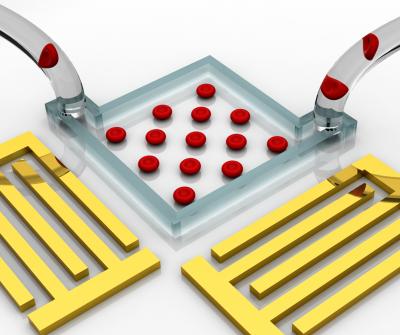Science Fiction
Dictionary
A B C D E F G H I J K L M N O P Q R S T U V W X Y Z
Acoustic Tweezers Create Living Cell Grid

An 'acoustic screwdriver' fabricated on a single chip can position dozens of tiny objects or even living cells in a pre-defined grid. The pattern can be imposed in just a few seconds at very low power. This technology could be used in fields like tissue engineering, cell studies and drug screening and discovery.
The acoustic tweezers are manufactured by fabricating an interdigital transducer onto a piezoelectric chip surface. These transducers are the source of the sound. Next, using standard photolithography, microchannels are fabricated in which a small amount of liquid with the cells or particles can move around freely. These microchannels were bonded to the chip to create the area for particle movement.

(Acoustic tweezers enable flexible on-chip manipulation
and patterning of cells using standing surface acoustic waves)
Acoustic tweezers differ from eyebrow tweezers in that they position many tiny objects simultaneously and place them equidistant from each other in either parallel lines or on a grid. The grid configuration is probably the most useful for biological applications where researchers can place stem cells on a grid for testing or skin cells on a grid to grow new skin. This allows investigators to see how any type of cell grows.Acoustic tweezers work by setting up a standing surface acoustic wave. If two sound sources are placed opposite each other and each emits the same wavelength of sound, there will be a location where the opposing sounds cancel each other. This location can be considered a trough. Because sound waves have pressure, they can push very small objects, so a cell or nanoparticle will move with the sound wave until it reaches the trough where there is no longer movement. The particle or cell will stop and "fall" into the trough.
If the sound comes from two parallel sound sources facing each other, the troughs form a line or series of lines. If the sound sources are at right angles to each other, the troughs form an evenly spaced set of rows and columns like a checkerboard. Here too, the particles are pushed until they reach the location where the sound is no longer moving.
Researchers tested the device using 1.9 micrometer polystyrene beads, red blood cells from cows and E. coli bacteria.
"Most cells or particles patterned in a few seconds," said Tony Jun Huang, assistant professor of engineering science and mechanics at Penn State. "The energy used is very low and the acoustic tweezers should not damage cells at all. Because they have different properties, the acoustic tweezers could also separate live from dead cells, or different types of particles."
The notion of tiny manipulators is a very handy idea. Science fiction writers have been busily imagining them for decades. More recently, fans may recall the sonic screw driver from the Dr. Who series.

(Dr. Who's sonic screwdriver)
From Eurekalert; thanks to Moira for pointing this story out.
Scroll down for more stories in the same category. (Story submitted 9/1/2009)
Follow this kind of news @Technovelgy.| Email | RSS | Blog It | Stumble | del.icio.us | Digg | Reddit |
Would
you like to contribute a story tip?
It's easy:
Get the URL of the story, and the related sf author, and add
it here.
Comment/Join discussion ( 0 )
Related News Stories - (" Biology ")
Black Fungus Blocks Radiation
'You were surrounded by Astrophage most of the time' - Andy Weir, 2021.
Lunar Biorepository Proposed For Cryo-Preservation Of Earth Species
'...there was no one alive who had ever seen them. But they existed in the Life Bank.' - John Varley, 1977.
Let's Make Slaver Sunflowers! Engineering Plants To Reflect Light
'The mirror-blossom was a terrible weapon.' - Larry Niven, 1965.
Machete-Wielding Philodendron Isn't Going To Take It Anymore
'The tree ended its wild larruping, stood like a dreaming giant liable to wake into frenzy at any moment.' - Eric Frank Russell, 1943.
Technovelgy (that's tech-novel-gee!) is devoted to the creative science inventions and ideas of sf authors. Look for the Invention Category that interests you, the Glossary, the Invention Timeline, or see what's New.
Science Fiction
Timeline
1600-1899
1900-1939
1940's 1950's
1960's 1970's
1980's 1990's
2000's 2010's
Current News
Golf Ball Test Robot Wears Them Out
"The robot solemnly hit a ball against the wall, picked it up and teed it, hit it again, over and again...'
Boring Company Vegas Loop Like Asimov Said
'There was a wall ahead... It was riddled with holes that were the mouths of tunnels.'
Rigid Metallic Clothing From Science Fiction To You
'...support the interior human structure against Jupiterís pull.'
Is The Seattle Ultrasonics C-200 A Heinlein Vibroblade?
'It ain't a vibroblade. It's steel. Messy.'
Roborock Saros Z70 Is A Robot Vacuum With An Arm
'Anything larger than a BB shot it picked up and placed in a tray...'
A Beautiful Visualization Of Compact Food
'The German chemists have discovered how to supply the needed elements in compact, undiluted form...'
Bone-Building Drug Evenity Approved
'Compounds devised by the biochemists for the rapid building of bone...'
Secret Kill Switch Found In Yutong Buses
'The car faltered as the external command came to brake...'
Inmotion Electric Unicycle In Combat
'It is about the size and shape of a kitchen stool, gyro-stabilized...'
Grok Scores Best In Psychological Tests
'Try to find out how he ticks...'
PaXini Supersensitive Robot Fingers
'My fingers are not that sensitive...'
Congress Considers Automatic Emergency Braking, One Hundred Years Too Late
'The greatest problem of all was the elimination of the human element of braking together with its inevitable time lag.'
The Desert Ship Sailed In Imagination
'Across the ancient sea floor a dozen tall, blue-sailed Martian sand ships floated, like blue smoke.'
The Zapata Air Scooter Would Be Great In A Science Fiction Story
'Betty's slapdash style.'
Thermostabilized Wet Meat Product (NASA Prototype)
There are no orbiting Michelin stars. Yet.
Could Crystal Batteries Generate Power For Centuries?
'Power could be compressed thus into an inch-square cube of what looked like blue-white ice'
